by Bruce Wells | Feb 1, 2019 | Energy Education Resources
Readable energy education resources from the Society of Petroleum Engineers.
“Oil and Natural Gas is SPE’s fun, colorfully illustrated, and information-filled book on the history and uses of oil. This hardbound book is appealing to kids of all ages and adults! Currently available in Arabic, Chinese, English, French, Russian, Spanish and Portuguese.” – Energy4me
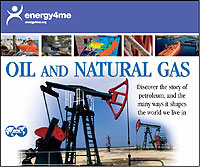 Detailed illustrations tell the story of the industry’s heritage in Oil and Natural Gas – a book from the Society of Petroleum Engineers. Best of all, it can be downloaded for free, thanks to Energy4me.
Detailed illustrations tell the story of the industry’s heritage in Oil and Natural Gas – a book from the Society of Petroleum Engineers. Best of all, it can be downloaded for free, thanks to Energy4me.
Discovering the story of petroleum – and the many ways it shapes the world – is the theme of this illustrated guide to the industry’s past, present and future.
“Our world is ruled by oil. People have used oil for thousands of years, but in the last century we have begun to consume it in vast quantities,” begins the first chapter, which explains one of the world’s largest and most complex industries.
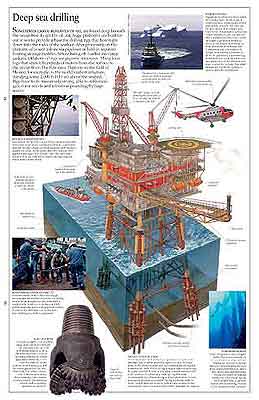 Oil and Natural Gas is an educational book specifically targeted for students. The book, adapted for SPE from a 2007 edition by DK Publishing, London, features such topics as ancient oil, oil for light, natural gas, deepwater technology, piped oil, refineries, global oil, electricity, oil substitutes, and job opportunities.
Oil and Natural Gas is an educational book specifically targeted for students. The book, adapted for SPE from a 2007 edition by DK Publishing, London, features such topics as ancient oil, oil for light, natural gas, deepwater technology, piped oil, refineries, global oil, electricity, oil substitutes, and job opportunities.
In 74 pages, the hardbound edition offers young people a surprisingly comprehensive introduction to the history and many uses of oil. Detailed illustrations tell much of the story.
With more than 79,000 members in 110 countries, SPE shares technical knowledge about the upstream oil and natural gas industry. The society’s energy education website is for students, teachers.

Oil and Natural Gas is available at the “essential energy education” SPE website Enery4me, designed to help Americans become more educated energy consumers. SPE members are available to make presentations at a schools — and can provide copies of the book for the library or classroom.
_______________________________
AOGHS.ORG welcomes sponsors to help us preserve petroleum history. Please support this energy education website with a donation. Contact bawells@aoghs.org for membership information. © 2020 Bruce A. Wells.
Citation Information: Article Title: Legend of “Story of Petroleum.” Author: Aoghs.org Editors. Website Name: American Oil & Gas Historical Society. URL: https://aoghs.org/energy-education-resources/spe-story-of-petroleum. Last Updated: December 8, 2020. Original Published Date: June 1, 2005.
by Bruce Wells | Mar 10, 2018 | Energy Education Resources
Traveling exhibits explain earth science and oil history.
It trucks petroleum history from the oil patch to teachers and students. It educates them about the modern exploration and production industry. It’s the interactive Mobile Energy Education Training Unite from the heart of the Pennsylvania oil patch. Nice to MEET-U.
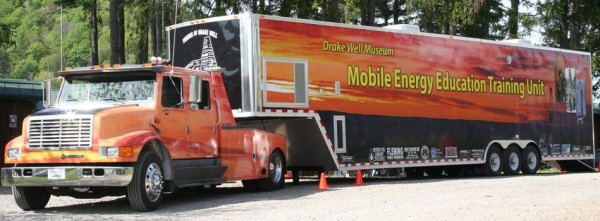
The traveling exhibit includes a colorful exterior and the internal exhibits that “went from papers taped on the wall in 2009 to 14 televisions and three-dimensional objects,” notes the MEET-U newsletter.
When Pennsylvania students cannot find time to visit a museum to learn about energy, an 18-wheeler brings their state’s petroleum history to them: MEET-U.
Since its updated version in 2011, the Mobile Energy Education Training Unit annually tours schools.
The traveling exhibits include bright exterior graphics and internal age-adaptable exhibits that “went from papers taped on the wall in 2009 to 14 televisions and three-dimensional objects,” notes Drake Well Museum’s MEET-U website page.
Thanks to museum staff, the trailer includes historical exhibits and oil patch artifacts that educate visitors about Pennsylvania’s rich petroleum heritage – and the evolution of modern exploration and production technologies. The students’ reviews have been positive.
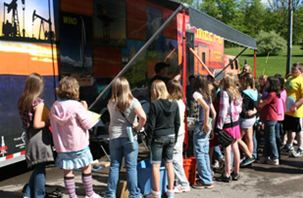
MEET-U includes historical exhibits that educate visitors about Pennsylvania’s rich petroleum heritage.
“Since opening in the summer of 2009, over 90,000 people have visited the educational exhibits in MEET-U in a number of cities, towns, fairs and other events in Pennsylvania, New York, and Ohio,” the museum proclaims. “In 2012 over 20,000 people saw MEET-U.”
MEET-U also has developed winter programs. The rig travels into classrooms targeting 4th graders and meeting state and national standards in social studies, economics, and science.
Improvements include a second touch-screen monitor. MEET-U is designed to be divided into three zones: the using zone, the finding/production zone, and the energy zone.
The energy zone asks visitors to choose energy source for the future – and presents the pros and cons to their choice.
The tractor-trailer truck logged more than 7,000 miles in 2010 – and participated in three forums, three industry functions, four fairs and five festivals to educate about 30,000 adult visitors.
MEET-U participated in the 2010 Boy Scouts of America camp at Moraine State Park in September, where 9,000 scouts registered for the three-day event.
“Due to the overwhelming success of the project, MEET-U is already scheduled for 23 schools visits, six industry events and 14 community fairs or festivals in 2011,” the website notes. “The key word here is already, because we know there will more.”
Please support the American Oil & Gas Historical Society and this website with a donation.
by Bruce Wells | Jul 21, 2016 | Energy Education Resources
The importance of preserving petroleum history, one story at a time.
Millions of Americans have worked in the petroleum industry and many have left family records and photographs of their “oil patch” careers. The AOGHS American Oil & Gas Families project and museums listing offer help in locating suitable homes for preserving the histories of America’s oil families.
Adding Family Petroleum Heritage to Museum Collections
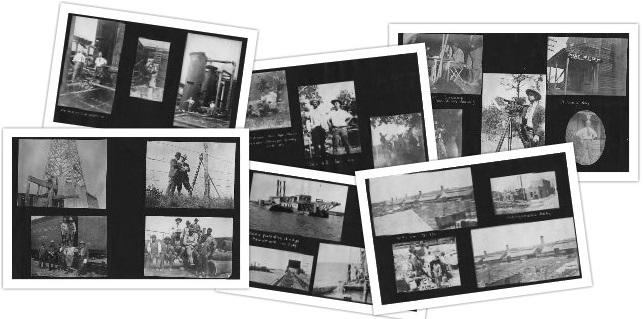
Albert Jeffreys in Texas, Louisiana, Romania, Pennsylvania and England, 1904-1913. Family photography preserved by his granddaughter, Sheila Morshead.
Finding the Right Oil and Gas Museum
In 2016, California resident Sheila Morshead contacted the American Oil & Gas Historical Society about preserving her family’s photo albums — a significant photo collection of petroleum-related images documenting her grandfather’s early 20th century career.
After finishing scanning circa 1910 images, Sheila said she hoped to find a good home for preserving her increasingly fragile originals. Many of her grandfather’s images came from the Beaumont, Texas, region (with others from Louisiana and as far away as England and Romania). She hoped someone would want to preserve the original album pages.

Thanks to Troy Gray, director of the Spindletop-Gladys City Boomtown Museum at Lamar University in Beaumont, Texas, Sheila accomplished her preservation mission.
Some of Sheila’s photos depict early refineries at Beaumont. Others show oil terminals in Galveston Bay, a 1909 pumping station under construction near Moores, Louisiana, and even the apparently good fishing at Port Bolivar in the Gulf of Mexico (a few examples out of more than 120 pages are below).
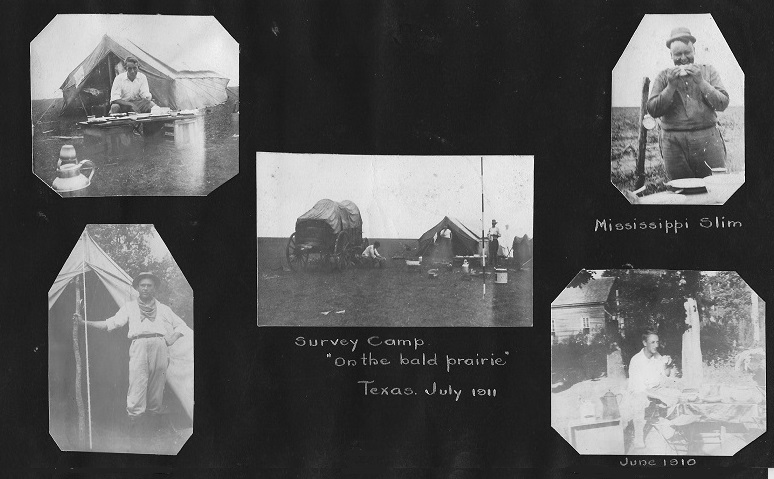
One of the more than 120 family album pages of the petroleum-related career of Albert Jeffreys to be part of the permanent collection of the Spindletop-Gladys City Boomtown Museum thanks to his granddaughter.
One page from the album depicts photos from a survey camp with tents and an equipment wagon on “the bald prairie” of Texas in July 1911. It includes a photo of “Mississippi Slim,” her grandfather’s co-worker.
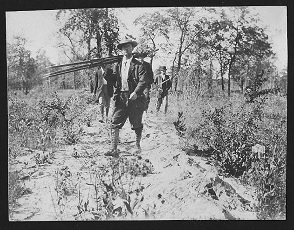
Sheila Morshead continues to research details about her grandfather’s career. She believes this is a 1912 photo of Albert Jeffreys with his surveying tripod.
“My Grandfather was Albert Jeffreys from Great Britain,” Sheila explains about the family images, adding that Albert “Jeff” Jeffreys first arrived in the United States in 1908. The next year he got married in Shreveport, Louisiana. Albert’s wife Florence – “Flo” – also was from Great Britain, Sheila adds. “Their daughter Dorothy Kathleen Jeffreys – my mother – was born in Fort Worth, Texas, in January 1912.”
After a few busy years in Texas, Albert’s oil patch career took him to the Caucasus region of southwestern Russia in 1914. “He was sent there by the British government to work in the oilfields for his service to the country during World War I,” explains Sheila, who studied early chapters of Dan Yergin’s The Prize, to learn petroleum industry history.
“Albert eventually escaped during the Bolshevik revolution by way of Norway and returned to England,” adds his granddaughter. “I am trying to decipher the many stamps on his old passport. Needless to say, I am getting pleasantly lost in looking up British oil companies.”
After talking with Troy about his museum’s collections at the Lamar University, she removed a few original images to keep for siblings. She plans on donating all the rest as she continues to research dates and other family documents.
Albert Jeffreys Family Collection
“Here are some annotations about the scanned pictures,” Shelia noted when she emailed AOGHS seeking help in locating an appropriate oil museum or library to preserve them. “There are lots more pictures, and I can do more exact research on dates, but as you can see most have locations written on them and some dates.”

The family album includes a cable-tool oil well (with walking beam). Next to it is a photo of two unidentified men with surveying equipment. A third photo shows men standing in front of a New York Central and Hudson River Railroad car; another depicts a pipeline laying work crew.
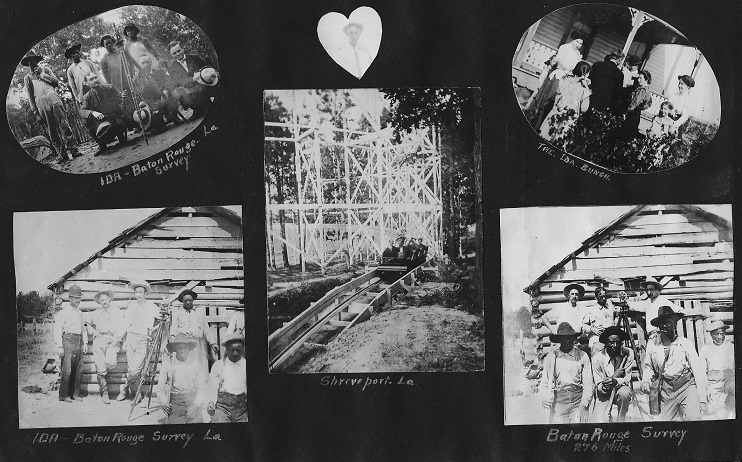
Undated images from Baton Rouge, Louisiana, include Albert Jeffreys (in heart) and his surveying co-workers along with an “Ida Bunch” family photo and riding a roller coaster in Shreveport.

After returning from England to Louisiana oilfields in 1909, the family made stops in Handley and Electra, Texas, which included a rare blizzard, before moving on to New Orleans.

Three of Albert Jeffreys’ images documenting the Magnolia Company refinery in Beaumont, Texas, circa 1912.
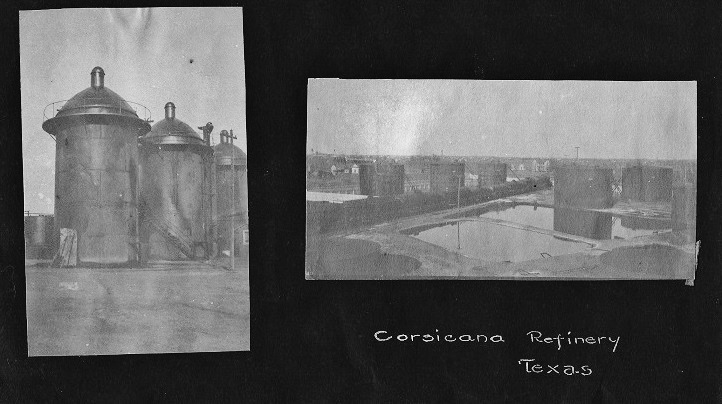
In addition to images of the Magnolia oil refinery, Albert Jeffreys photographed other circa 1910 refineries, including one near Corsicana and the “Chaison Refinery” below.
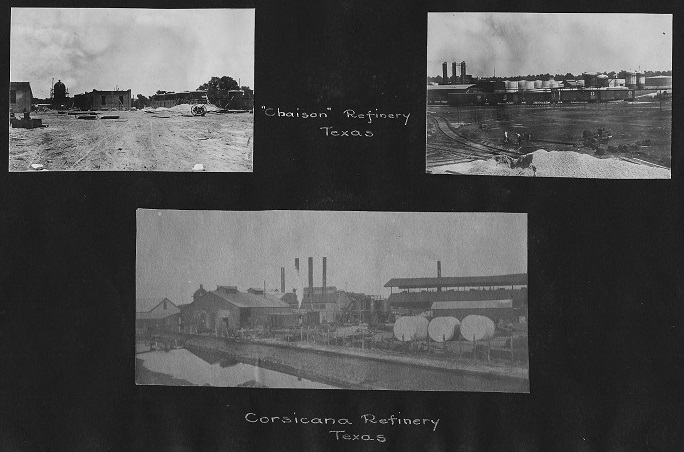
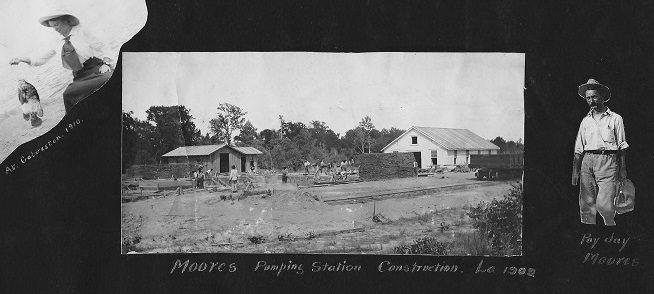
Both Albert and wife Florence enjoyed fishing in Galveston Bay between his frequent surveying trips in Texas in 1910 – and a visit to the pipeline pumping station in Moores, Louisiana.
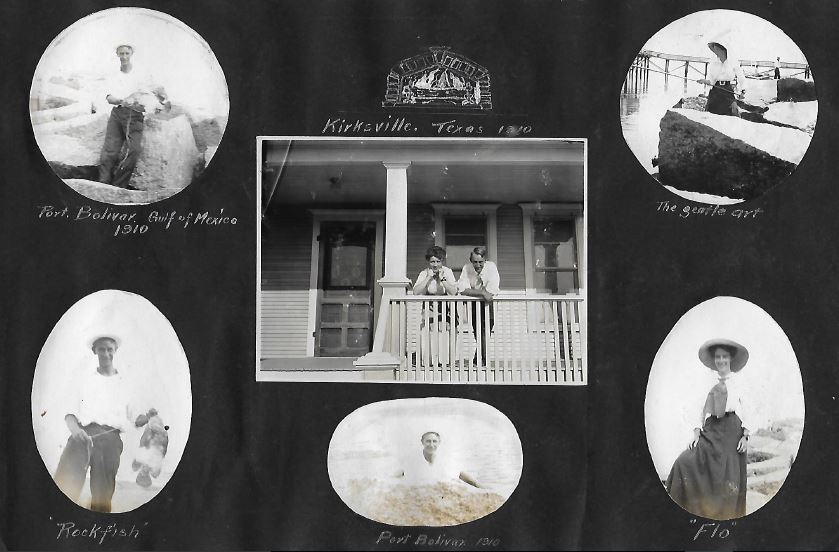
Albert “Jeff” and “Flo” Jeffreys lived in Kirksville, Texas, and enjoyed fishing out of Port Bolivar around 1911.
With many family photos in the process of being preserved for posterity, Albert “Jeff” Jeffery’s petroleum career continues to fascinate his granddaughter. “I still intend to do more looking as it is a puzzle full of interesting pieces,” says Sheila.
“For example, my grandfather’s father worked for a British oil company and my grandfather’s son Stanley Rex Jeffreys was a geologist with the landmark geology survey of California, which I believe was completed sometime in the 1950s and was part of the concerted effort to identify oil producing areas in California,” Shelia explains. “So, there were three generations of Jeffreys oil men.”
Geologic mapping in California began in 1826 when the first geologic survey in the state was done by a British naval officer, according to History of Geologic Maps of California of the California Geological Survey.
1901 Gusher at Spindletop
Albert Jeffreys worked in Texas oilfields just a few years after a famous oil discovery about three miles south of Beaumont. The January 10, 1901, “Lucas Gusher” at Spindletop Hill would soon lead to southeastern Texas producing more oil in one day than the rest of the world’s oilfields combined. Major petroleum companies like Texaco got started there.
Both the Spindletop-Gladys City Boomtown Museum and the Texas Energy Museum in Beaumont tell the story of the Spindletop well, a “wildcat” discovery that created the greatest petroleum boom in America – far exceeding the first U.S. oil discovery well in 1859 in Pennsylvania.
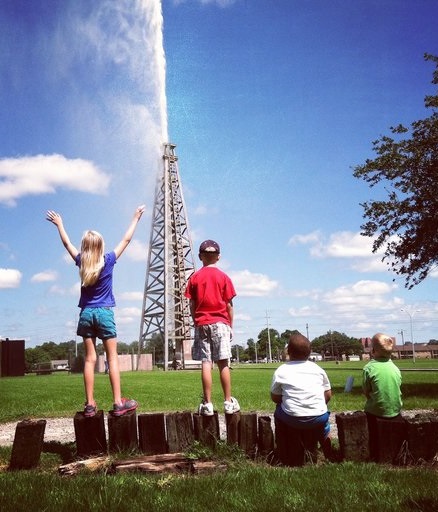
A replica wooden derrick recreates the excitement of a major oil discovery of January 10, 1901. Photo courtesy Spindletop-Gladys City Boomtown Museum at Lamar University in Beaumont, Texas.
Gladys City, now partially recreated on the museum’s grounds, was originally envisioned by Patillo Higgins of the Gladys City Oil, Gas and Manufacturing Company. Known as the Prophet of Spindletop, he predicted oil would be found near the city he designed in 1892. Spindletop launched the modern petroleum industry a few years later.
Learn more about finding a museum to preserve family photos at Oil Families.
_______________________
The American Oil & Gas Historical Society preserves U.S. petroleum history. Become an AOGHS supporting member and help maintain this energy education website and expand historical research. For more information, contact bawells@aoghs.org. Copyright © 2021 Bruce A. Wells. All rights reserved.
by Bruce Wells | Dec 11, 2011 | Energy Education Resources
The American Oil & Gas Historical Society has hosted energy education conferences and field trips — special gatherings of education professionals, including state and national teacher workshop practitioners, petroleum museums directors, trade associations, and oil and natural gas company representatives.

The historic Skirvin Hotel in Oklahoma City — site of the society’s popular 2007 Energy Education Conference & Field Trip.
A May 31 to June 2, 2007, Energy Education Conference & Field Trip in Oklahoma City brought together leading education experts. The Golden Driller statue in Tulsa was among the stops of a concluding field trip that followed panel discussions, classroom demonstrations, receptions and an awards banquet.
(more…)
 Detailed illustrations tell the story of the industry’s heritage in Oil and Natural Gas – a book from the Society of Petroleum Engineers. Best of all, it can be downloaded for free, thanks to Energy4me.
Detailed illustrations tell the story of the industry’s heritage in Oil and Natural Gas – a book from the Society of Petroleum Engineers. Best of all, it can be downloaded for free, thanks to Energy4me. Oil and Natural Gas is an educational book specifically targeted for students. The book, adapted for SPE from a 2007 edition by DK Publishing, London, features such topics as ancient oil, oil for light, natural gas, deepwater technology, piped oil, refineries, global oil, electricity, oil substitutes, and job opportunities.
Oil and Natural Gas is an educational book specifically targeted for students. The book, adapted for SPE from a 2007 edition by DK Publishing, London, features such topics as ancient oil, oil for light, natural gas, deepwater technology, piped oil, refineries, global oil, electricity, oil substitutes, and job opportunities.

















